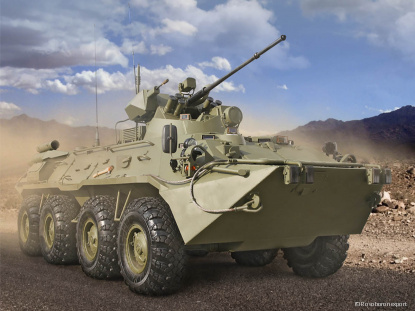
en formato pdf
The BTR-82A armored personnel carrier (APC) is designed to transport personnel of motor rifle units during the march or forces maneuver, including hasty crossing of water obstacles, protect the crew and troops against small arms fire, mines, shell fragments and NBC effects, and defeat enemy manpower and lightly armored targets.
The BTR-82A is the result of upgrading the BTR-80A APC in order to improve its main performance and service characteristics through the use of a higher-capacity power plant, an armament stabilizer, a combined (day/night) sight, as well as improvements to transmission and running gear units.
The vehicle is fitted with a unified fighting compartment with stabilized gun and machine guns. The TKN-4GA-01 combined (day/night) sight enables the gunner to fire the gun and machine gun at the halt and on the move, day and night. An armament system stabilized in two planes and new observation and sighting devices have improved the target detection and kill performance.
Equipping the BTR-82A with a new 300hp KamAZ-740.14-300 engine, higher-capacity shock absorbers, an upgraded transfer box, drive shafts, axles and unified final drives has increased the total service life of the vehicle, its average speed over rough terrain, improved the chassis reliability, ride comfort and mobility in general.
Its hull and turret armor is able to withstand small arms fire and shell and mine fragments. Spall liners are installed inside the vehicle for additional protection of the crew and troops.
The vehicle is fitted with an NBC protection system, fire-fighting equipment, a bilge pump system, a habitability support system.
The habitability conditions for the crew and troops have been improved through the use of an air conditioning system (heater, air conditioner) and a diesel generator.
The autonomous diesel generator set provides:
- operation of essential loads (armament stabilizer, sighting and surveillance devices, communications means) and saves the service life of the main engine by eliminating its running at the halt (in defense, at checkpoints, etc) to supply loads with electricity;
- battery charging with the non-running main generator;
- reduction in the vehicle’s thermal and acoustic signature.
New digital communications means have improved communications stability, secrecy and quality, extended control capabilities and enabled integration into a single tactical control system.










